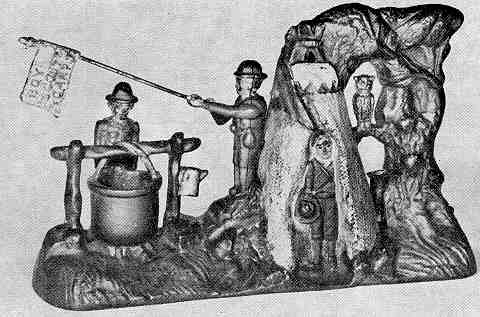Boy Scout Bank
by F.H. Griffith - HOBBIES Magazine - April, 1964

A mechanical bank that represents a very fine worthwhile organization is our choice as No. 118 in the numerical classification. This is the Boy Scout Bank and it well depicts one of the important and original activities of scouting, camping out. The Boy Scouts of America, since its inception, has been and continues to be a great stimulating constructive movement for boys in their formative years. The fact that a mechanical bank was made to more or less commemorate this organization during its early stages certainly adds a degree of interest and stature to the bank itself. And with the continuing increased activity and interest in scouting over the years, this naturally has reflected through to the Boy Scout Bank as an increasingly desirable collector’s item.
The bank was made by the J. & E. Stevens Co. of Cromwell, Conn., and very definitely designed by Charles A. Bailey. So far the writer has had no luck in locating any patent papers that would apply to the bank. This, like some other banks designed by Bailey, has no dates or other helpful information on the bank itself, however, this does not preclude the fact that the bank may have been covered by a regular or design patent. It is the writer’s opinion that if papers do exist covering the bank they are in the form of a design patent and future research will bring them to light. Stevens catalogs, in this case, are helpful in placing the approximate period in which the bank was originally produced. It is not shown in their 1911 catalog or prior to this time but it is pictured along with their Called Out Bank (HOBBIES, Oct., 1955), another Bailey item, in the 1917 catalog. So this narrows it down to a six year time period between 1911 and 1917.
The bank shown, which is from the fine collection of Leon Perelman of Merion, Pa., is in nice original condition with good paint. Colors are as follows: The base area around the tent is done in green highlighted in gold with some gray areas representing soil and rocks. The tree to the right of the tent is tan with green foliage over to the top of the tent. The owl perched in between is white with gold overtones. The tent is a cream color and a red pennant with gold staff rests against same. The large cooking pot is black with a silver handle, and the coffee pot is also silver. The scouts have brown uniforms and hats with orange socks and black shoes. Face and hands are flesh color. The flag held by the scout is white and the wording thereon, "Boy Scout Camp," is in gold.
To operate the bank a coin is placed in the provided slot located in the foliage of the tree on top of the tent. The coin stays in place. The lever, located underneath the owl, is then depressed. The coin drops into the bank automatically and the scout holding the flag raises it high over his head. Releasing the lever causes the scout to lower the flag.
Certain information as to the origin and so on of the scout movement is in order and of interest. The boy scout idea was founded in England by Sir Robert Baden-Powell. This was to develop self reliance, resourcefulness, courage and other hardy virtues among the recruits to the constables that were sent out to him in South Africa. After the Boer War he was invited to develop a program for boys based on his ideas and the program included two units in the United States. This was in 1908. In our country during this year the Sons of Daniel Boone was organized by Daniel Carter Beard and the Woodcraft Indians were organized by Ernest Thompson Seton.
In 1910 the actual Boy Scout movement as such was brought to the United States by William D. Boyce, a Chicago publisher. On a visit to England Boyce accidentally came across a boy scout in the street who directed and took him to a certain address he was seeking. The scout was most courteous and refused to accept the coin offered to him by Boyce. This intrigued Boyce and he checked into the scout movement, thus became interested and returned with this interest to the United States. The scouting movement was then incorporated as The Boy Scouts of America, February 8, 1910. In September of the same year Sir Baden-Powell visited the United States and under his direction the National Council of Boy Scouts was organized. President Howard Taft accepted the office of Honorary First President and Teddy Roosevelt was Honorary Vice President and Chief Scout. Daniel Carter Beard was the first National Scout Commissioner.
In 1916 the organization was granted a Federal Charter by Congress. It is non-sectarian, non-political, and neither military nor non-military in character. In 1963 the Boy Scouts of America had a membership total of 5,322,000.
Many basic ideas in back of the original boy scout movement as organized would seem to be more closely based on the Woodcraft Indians as set up by Seton. There are a number of books by various authors that go into many detailed phases of the scouting movement, its origins and so on, and anyone interested in the subject, beyond the information herewith, can pursue the matter further by use of these books.
In closing, the Boy Scout Bank is a very attractive item and in spite of the fact that it is a rather late bank, it is not readily available and somewhat difficult to find in nice original condition. It would logically follow that the bank would have a popular appeal and therefore be produced in quantities, however, it came rather late in the popularity era of mechanical banks and thus was not apparently manufactured over a period of years, nor were any great quantities ever made in any given time.
